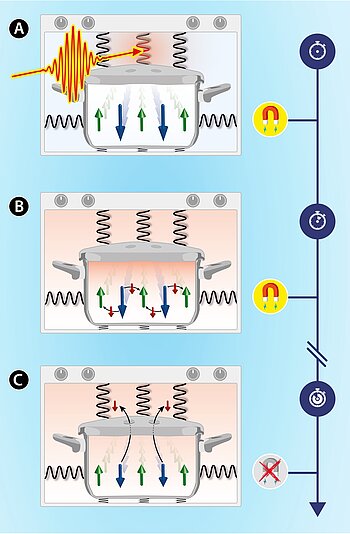When an insulating ferrimagnet is heated, the heat is first deposited in the atomic lattice which causes the atoms to move randomly around their cold positions. Finally, part of the heat also causes random rotation (precession) of the spins around their cold direction. Thus, magnetic order gets lost; the total magnetization (M1-M2) decreases and eventually vanishes if the temperature of the ferrimagnet exceeds a critical temperature, the so-called Curie temperature. Although this process is of fundamental importance, its dynamics are not well understood. Even for the ferrimagnet yttrium iron garnet (YIG), one of the most intensely researched ferrimagnets, it is unknown how long it takes until the heated atomic lattice and the cold magnetic spins reach equilibrium with each other. Previous estimates of this time scale differ from each other by a factor of up to one million.
A team of scientists from Berlin (Collaborative Research Center / Transregio 227 Ultrafast Spin Dynamics, Fritz Haber Institute and Max Born Institute), Dresden (Helmholtz Center), Uppsala (Sweden), St. Petersburg (Russia), and Sendai (Japan) have now revealed the elementary steps of this process. "To instantaneously and exclusively heat up the atomic lattice of a YIG film, we use a very specific and novel kind of stimulus: ultrashort bursts of laser light at terahertz frequencies. With a subsequently arriving visible laser pulse, we can then step-by-step trace the evolution of the initially cold magnetic spins. Essentially, we record a stop-motion movie of how the magnetization evolves." says Sebastian Maehrlein, who conducted the experiments. His colleague Ilie Radu from summarizes: "Our observations are striking. We found that sudden heating of the atomic lattice reduces the magnetic order of the ferrimagnet on two distinct time scales: an incredibly fast scale of only 1 ps and a 100,000 times slower scale of 100 ns."
